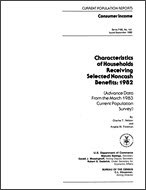Characteristics of Households Receiving Selected Noncash Benefits: 1982 (Advance Data From the March 1983 CPS)
Characteristics of Households Receiving Selected Noncash Benefits: 1982 (Advance Data From the March 1983 CPS)
Introduction
This report contains data on the characteristics of households receiving noncash benefits in 1982. These data were obtained from the March 1983 Current Population Survey (CPS) conducted by the Bureau of the Census. Noncash benefits can be defined as benefits received in a form other than money that serve to enhance or improve the economic well-being of the recipient. Data collection in March 1983 concentrated on two major categories of noncash benefits: those that are usually defined as public transfers and employer- or union-provided benefits to employees. In the area of public noncash transfers, the survey covered the following programs: the Food Stamp Program, the National School Lunch Program, public and other subsidized rental housing, Medicare health insurance, Medicaid health insurance, and CHAMPUS, VA, or military health insurance. Data were collected for two types of employer- or union-provided noncash benefits: pension plans and group health insurance plans.
A Note on Language
Census statistics date back to 1790 and reflect the growth and change of the United States. Past census reports contain some terms that today’s readers may consider obsolete and inappropriate. As part of our goal to be open and transparent with the public, we are improving access to all Census Bureau original publications and statistics, which serve as a guide to the nation's history.
Others in Series
Publication
Publication
Publication




